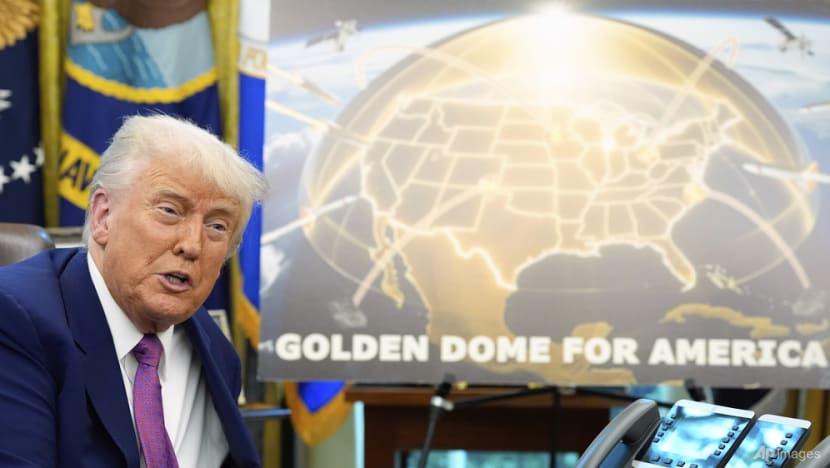Trump announces 'Golden Dome' missile defence project plans

US President Donald Trump speaks in the Oval Office of the White House, May 20, 2025, in Washington. (Photo: AP/Alex Brandon)
WASHINGTON: US President Donald Trump announced plans on Tuesday (May 20) for a future Golden Dome missile defence programme, which would likely cost taxpayers tens of billions of dollars and take years to make a reality.
The president said that it should be operational by the end of his second term.
"In the campaign, I promised the American people I would build a cutting-edge missile defence shield," Trump said at the White House. "Today I am pleased to announce we have officially selected architecture for this state-of-the-art system."
If realised, the system would mark the first time that the US would put weapons in space, which could be fired to destroy an incoming missile during flight.
Trump also announced that Gen Michael Guetlein, who currently serves as the vice chief of space operations, will be responsible for overseeing Golden Dome's progress.
Golden Dome is envisioned to include ground and space-based capabilities that can detect and stop missiles at all four major stages of a potential attack: detecting and destroying them before a launch, intercepting them in their earliest stage of flight, stopping them midcourse in the air, or halting them in the final minutes as they descend toward a target.
For the last few months, Pentagon planners have been developing options, which a US official described as medium, high and “extra high” choices, based on their cost, that include space-based interceptors.
The administration picked the “high” version, with an initial cost ranging between US$30 billion and US$100 billion, according to the official, who spoke on condition of anonymity to detail plans that have not been made public.
The difference in the three versions is largely based on how many satellites and sensors in space would be purchased, and for the first time, space-based interceptors.
The Congressional Budget Office estimated this month that just the space-based components of the Golden Dome could cost as much as US$542 billion over the next 20 years. Trump has requested an initial US$25 billion for the programme in a proposed tax break bill that needs to be approved by Congress.
The Pentagon has warned for years that the newest missiles developed by China and Russia are so advanced that updated countermeasures are necessary. Golden Dome's added satellites and interceptors - where the bulk of the programme's cost is - would be focused on stopping those advanced missiles early on or in the middle of their flight.
The space-based weapons envisioned for Golden Dome “represent new and emerging requirements for missions that have never before been accomplished by military space organisations,” Gen Chance Saltzman, head of the US Space Force, told lawmakers at a hearing on Tuesday.
China and Russia have put offensive weapons in space, such as satellites with the ability to disable critical US satellites, which can make the US vulnerable to attack.
But there’s no money for the project yet, and the programme overall is “still in the conceptual stage”, said newly confirmed Air Force Secretary Troy Meink to senators on Tuesday.
While the president picked the concept he wanted, the Pentagon is still developing the requirements that Golden Dome will need to meet, which is not how new systems are normally developed.
The US already has many missile defence capabilities, such as the Patriot missile batteries the US has provided to Ukraine to defend against incoming missiles as well as an array of satellites in orbit to detect missile launches. Some of those existing systems will be incorporated into Golden Dome.
Trump directed the Pentagon to pursue the space-based interceptors in an executive order during the first week of his presidency.
Some analysts have cast scepticisms on the price and time frame for the completion of Golden Dome, saying it is likely to be far more expensive and take much longer than Trump's estimates.
“The US would have to put a lot (of) satellites … sensors and interceptors … into space – we're talking many thousands. How are they going to finish it in three years? I have no idea,” said Grant Newsham, a senior research fellow at the Japan Forum for Strategic Studies.
During the announcement, Trump referred to former President Ronald Reagan’s Strategic Defense Initiative – dubbed Star Wars, a defensive system against potential nuclear attacks.
Reagan’s ballistic missile barrier programme was widely derided when proposed in 1983 amid the Cold War, with criticisms that it was closer to science fiction.
“We will truly be completing the job that President Reagan started 40 years ago, forever ending the missile threat to the American homeland,” Trump said.
Newsham said that like Reagan’s Star Wars system, efforts to realise Trump's plan will spur America’s defence technology development whether it succeeds or not.
“America's missile defense system is not very good as it is, but this would be an effort to make it into something much tighter,” he told CNA’s Asia Now on Wednesday.
“(The US) innovation will come to the fore, and I think we can get something that is a whole lot better than what we have today. It may not be exactly like it's envisioned, but we'll have much better ability to address the threats we face.”



















